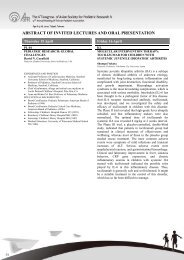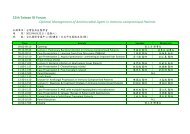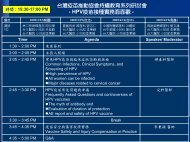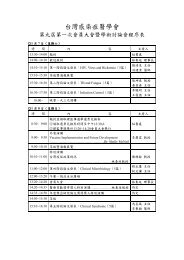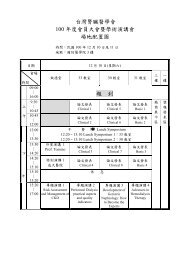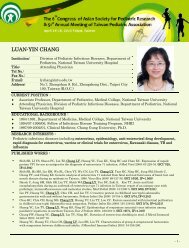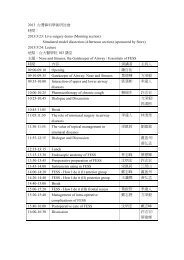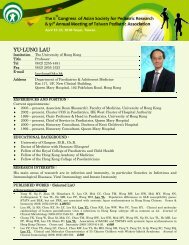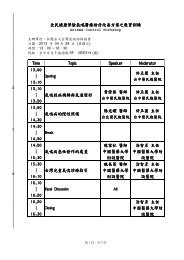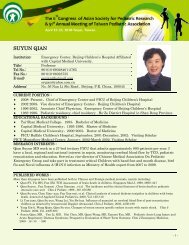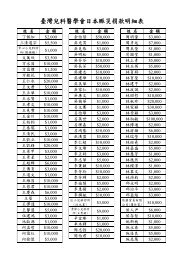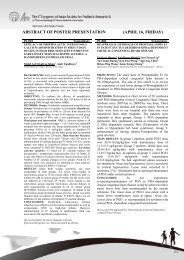ABSTRACT OF POSTER PRESENTATION (APRIL 17, SATURDAY)
ABSTRACT OF POSTER PRESENTATION (APRIL 17, SATURDAY)
ABSTRACT OF POSTER PRESENTATION (APRIL 17, SATURDAY)
You also want an ePaper? Increase the reach of your titles
YUMPU automatically turns print PDFs into web optimized ePapers that Google loves.
P2-043 Allergy/Immunology/Rheumatology P2-044 Neuropsychiatry (Neurology)FOOD ALLERGEN SPECIFIC IGEANTIBODIES IN PRIMARYSCHOOLCHILDRENSEQUENTIAL CHANGE IN REGIONALCEREBRAL BLOOD FLOW ABNORMALITY INPATIENTS WITH KAWASAKI DISEASEHsin-Lin Wu 1 , Kong-Sang Wan 2 , Tzee-Chung Wu 3 ,Keh-Gong Wu 3 , Winnei Yang 4 , Ting-Fang Chiu 1 ,BetauHwang 1,5Taipei City Hospital Zhongxiao Branch 1 , Taipei City Hospital RenaiBranch 2 , Taipei Veterans General Hospital 3 ,Taipei City Hospital YangMingBranch 4 , Taipei City Hospital Zhongxiao Branch and National Yang MingUniversity, Taiwan 5Toshiyuki Hikita 1 , Tatsuro Kaminaga 2 , Suguru Wakita 1 ,Yasushi Fujii 1 , Yukishige Yanagawa 1Pediatrics, Teikyo University sch of Med 1 , Radiology, Teikyo University School ofMedicine, Japan 2OBJECTIVES: To evaluate the types of food allergens andits relationship with aeroallergens in primary schoolchildren inTaipei City , the total IgE by using Phadiatop infant andspecific IgE against Dermatophagoides pteronyssinus ,Dermatophagoides farinae, Blomia tropicalis,Germancockroach, egg white, casein, alpha-lactoalbumin,beta-lactoglobulin, shrimp, kiwi, & mango were detected inthe sera of 88 primary schoolchildren who had clinicalsuspicion of food allergy and, aged ranged from 6 to 12 yearsold.METHODS: The 3-5 ml of serum was tested byradioabsorbent method using Pharymacia ImmunoCAP-250(Phadia Taiwan Inc.). Serum levels of total IgE andallergen-specific IgE were determined by fluorescence enzymeimmuno-assay (FEIA) using the ImmunoCAP-system (Phadia,Uppsala, Sweden). The ImmunoCAP is an in vitro-specificIgE test that uses a three-dimensional cellulose solid allergenphase.MAIN RESULTS: Among the 88 children with suspicioushistory of food allergy, 7 (8.0 %) children have IgE level lessthan 0.35 PAu/L indicating negative for allergy, other 32(36.4%) children have only positive specific IgE antibodiesagainst aeroallergens including Dermatophagoidespteronyssinus in 32(100 %), Dermatophagoides farinae in 31(96.9%), Blomia tropicalis in 28 (87.5%), and cockroach in 11(34.4%). The remaining 49 (55.9 %) have positive specific IgEantibodies against various foods. Two of them are pure foodsallergy including positive specific IgE antibodies against eggwhite in 2, against milk, casein, and alpha-lactoalbumin ineach 1. Forty-seven (53.4%) children have positive specificIgE antibodies against both aeroallergens and various foods.The positive foods allergens are egg white in 26 (53.1 %),shrimp in 23 (46.9 %), milk in 15 (30.6 %), casein in 10 (20.4%), alpha lactoalbumin in 9 (18.4 %), beta lactoglobulin in 4(8.2 %), kiwi in 4 (8.2 %) and mango in 4 (8.2%). Of the 79children with positive specific IgE antibodies againstaeroallergens, 47 (59.5%) have positive evidence of specificIgE antibodies against foods allergens.CONCLUSION: The primary schoolchildren with clinicalsuspicion of food allergies, 55.9 % have positive sera specificIgE antibodies against various tested foods in this study. Themost common allergens are egg white, shrimp and milk. Mostof children (95.9 %) with positive specific IgE antibodiesagainst foods allergens are combined with positive specificIgE against aeroallergens. On the contrary, only 59.5 % ofchildren with positive of specific IgE antibodies againstaeroallergens have the evidence of positive specific IgEantibodies against foods allergens.BACKGROUND: We reported localized cerebralhypoperfusion in 8 patients with Kawasaki’s disease (KD)using brain single-photon emission computed tomography(SPECT) at the 4th Congress of the Asian Society for PediatricResearch. However, we did not discuss whether thishypoperfusion was transient or not, and detected it only in itsacute phase. Sequential changes during such hypoperfusionshave not been discussed by previous studies. In this study,follow-up brain SPECT was performed in these 8 KD patientsand in new KD patients.OBJECTIVE: This study aimed to estimate the sequentialchange in localized cerebral hypoperfusion in KD patients overa period time.METHODS: This study included 22 KD patients admitted toTeikyo University Hospital and was approved by the TeikyoUniversity Ethics Committee. KD was diagnosed on the basisof standard diagnostic criteria and all subjects presented inacute phase of KD. All patients underwent brain SPECT fromday 6 to day 30 from the onset of KD, after an informedconsent was obtained from their parents. Ten of 22 patientsunderwent follow-up SPECT from 1 to 12 months after firstexamination. Six of 10 patients underwent further follow-upSPECT from 12 to 36 months after first examination.The patients were injected with 190–550 MBq of 99m Tchexamethylpropylene amine oxime under anesthesia. Dataacquisition was done using a two-headed gamma camera after5 min of administering the injection. Reconstructed transverseimages were obtained and examined by one board-certifiedradiologist.MAIN RESULTS: Localized cerebral hypo perfusion wasobserved in 18 of 22 patients in the initial SPECT and detectedin 7 patients in the second SPECT (from 1 to 11 months). Itwas resolved in 3 patients in the second SPECT (from 1 to 14months). Six of these 7 patients underwent further follow-upsafter the second SPECT. Localized cerebral hypoperfusionwas not detected in the third to sixth SPECT examinations(from 4 to 36 months) in 2 of these 6 patients. Localizedcerebral hypoperfusion persisted in 5 of 10 patients throughoutthe study period.CONCLUSION: Localized cerebral hypoperfusion wasdetected between 1 and 24 months after the onset of KD, anddisappeared in half of the patients during the study period(from 4 to 36 months after onset).[Keywords] Kawasaki disease, localized cerebral hypoperfusion,single-photon emission computed tomography, 99mTc-hexamethylpropylene amine oxime[Keywords]Allergen ,Food Allergy, Specific IgE276



